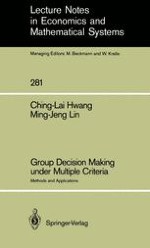1987 | Buch
Group Decision Making under Multiple Criteria
Methods and Applications
verfasst von: Prof. Dr. Ching-Lai Hwang, Dr. Ming-Jeng Lin
Verlag: Springer Berlin Heidelberg
Buchreihe : Lecture Notes in Economics and Mathematical Systems
Enthalten in: Professional Book Archive
